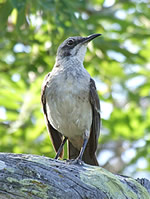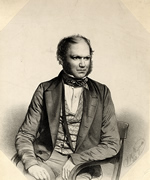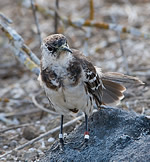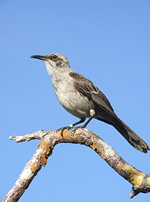Darwin's mockingbirds knock finches off perch
You need Adobe Flash Player, or an HTML5 enabled web browser, and JavaScript enabled to watch this video.
Visit the Adobe website to download the latest Adobe Flash Player
Mockingbirds from the Galapagos Islands, not finches, gave Charles Darwin his ideas about evolution.
Darwin's finches are the better-known birds connected with helping Darwin come to his conclusions on evolution. However, it was the little-known mockingbirds that were the key.

San Cristobal mockingbird © Zoological Museum of the University of Zurich
Voyage of the Beagle
While on his 5-year voyage on the Beagle to South America, Darwin noticed differences in mockingbirds he saw on different islands in the Galapagos.
Island differences
When he arrived on San Cristobal Island (then known as Chatham), he immediately saw that the mockingbirds were similar to ones he had collected in South America.
The next island he visited was Floreana (known as Charles Island at that time). Darwin was surprised to see the mockingbirds were all noticeably different from those on San Cristobal.
Darwin's notes
Darwin wrote down these differences and those he saw in mockingbirds in two other islands. Crucially, he noted which mockingbird was from which island, something he didn’t do with the finches.

Charles Darwin
This led Darwin to question 'the stability of species’, as he put it then. This insight eventually led to Darwin’s idea of evolution by natural selection.
Mockingbird recognition
Randal Keynes, Charles Darwin’s great-great-grandson said ‘Darwin’s first sightings of the Galapagos mockingbirds were to prove historic.’
‘Darwin had come to understand that species can change and this ultimately led to our present understanding of life on Earth.’
So the mockingbirds take their rightful iconic status in the history of evolutionary theory.
Type specimens
These Floreana and San Cristobal mockingbirds are perhaps the most important birds Darwin ever collected. They are the specimens used to describe the two species for the very first time, known as the type specimens.
Mockingbirds near extinction

Floreana mockingbird © Zoological Museum of the University of Zurich
When Darwin visited the Galapagos, mockingbirds were very common. But by 1880 they were extinct on Floreana, most likely due to introduced species such as goats and rats.
Today, there are only around 200 birds living on neighbouring islands and they are now one of the rarest birds in the world.
Reintroducing the mockingbirds
The mockingbird specimens collected by Darwin have been looked after by scientists at the Natural History Museum. And, more than 170 years later, they are playing a crucial role in helping to save the species.
Scientists at the Natural History Museum are supporting a conservation project run by the University of Zurich to reintroduce the species to Floreana.

Mockingbird, San Cristobal © Zoological Museum of the University of Zurich
Scientists need to find out which of the surviving populations are most similar genetically to the original population that died out.
To find out which of the surviving populations are most similar genetically to the original population that died out, scientists analysed DNA taken from the foot pads of the historic Museum specimens. They then compared this genetic information with the surviving bird populations.
DNA research
Karen James, a molecular biologist at the Natural History Museum, checked the DNA samples to make sure they were not contaminated with other genetic material.
‘It’s really important when you’re examining DNA from old specimens that you don’t get contamination from other specimens in the same drawer or laboratory.’ Fortunately, the researchers were able to get usable DNA from the foot pads of both of Darwin’s specimens.
The DNA analysis revealed that 1 of the 2 surviving populations on Champion island, though small and inbred, still harbours unique genetic information not found in the larger Gardner-by-Floreana island population but, crucially, present on Floreana island in 1835.
Understanding the genetic information of the surviving bird populations is helping scientists to devise a reintroduction strategy that is more likely to work and is more like the original population Darwin found when he first visited over 150 years ago.
The Galapagos Conservation Trust (GCT), with the Charles Darwin Foundation (CDF), is campaigning to help save the Floreana mockingbird.